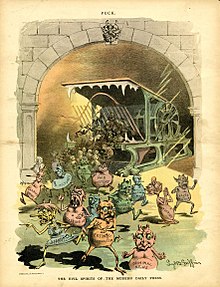
Back صحافة صفراء Arabic হালধীয়া সাংবাদিকতা Assamese Sarı jurnalistika Azerbaijani Tradschbladdl BAR হলুদ সাংবাদিকতা Bengali/Bangla Premsa groga Catalan Žlutá žurnalistika Czech Regenbogenpresse German Κίτρινος Τύπος Greek Yellow journalism English

Yellow journalism or the yellow press is a type of journalism that does not report much real news with facts. It uses shocking headlines that catch people's attention to sell more newspapers. Yellow journalism might include exaggerating facts or spreading rumors.
Yellow press newspapers have several columns and front-page headlines about different types of news, such as sports and scandals. They use bold layouts (with large illustrations and perhaps color), and stories reported using unnamed sources. The term was often used to talk about some large New York City newspapers around 1900 as they fought to get more readers than the other newspapers.[1]
In 1941, Frank Mott said that there were five things that made up yellow journalism:[2]
- headlines in huge print that were meant to scare people, often of news that wasn't very important
- using many pictures or drawings
- using fake interviews, headlines that didn't tell the whole truth, pseudoscience (fake science), and false information from people who said they were experts
- full-color parts of the newspaper on Sundays, usually with comic strips (which is now normal in the United States)
- taking the side of the "underdog" against the system.
- ↑ Campbell (2001)
- ↑ Frank Luther Mott 1041. American Journalism, p. 539. online
